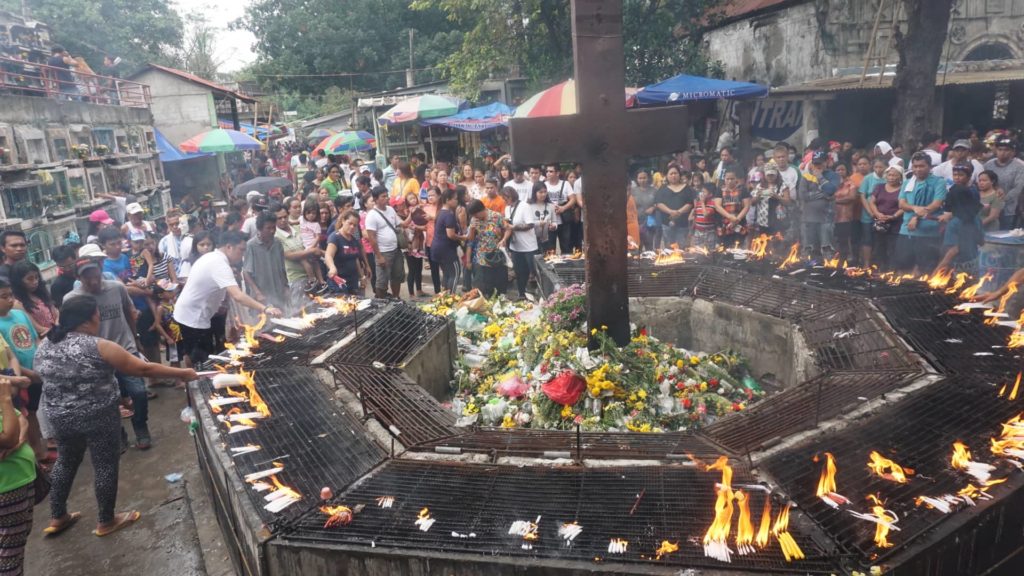
People visit the Calamba Cemetery in Cebu City in this 2019 file photo of All Souls’ Day.
CEBU CITY, Philippines — Why do we celebrate the Kalag-Kalag or Undas on Nov. 1 and 2 or on All Saints’ Day and All Souls’ Day respectively?
The All Saints’ Day and the All Souls’ Day are celebrated separately in the sense that the saints, who have not been recognized here on earth but have been believed to enter heaven, are the focus of the celebration on November 1 while all the souls especially in purgatory are the focus of the celebration on November 2. That is the definition in the Catholic context.
READ: LIVE UPDATES: Kalag-Kalag or Undas 2023
Msgr. Tan’s insights on Kalag-Kalag
This is according to Monsignor Joseph Tan in an interview by CDN Digital on November 1 in 2021 as Cebu and the country was starting to come out of the pandemic.
Tan, spokesperson of the Archdiocese of Cebu, shared his insights on what Kalag-Kalag was all about in the Catholic and Church context and is relevant today. So we are sharing again what Monsignor Tan said during that interview in 2021.
READ: Cebu Catholic Church priest urges faithful to wear saintly attires not scary costumes
November 1 for saints
Tan said All Saints Day on November 1, is a day dedicated to the saints who have not been named here on Earth, yet who are believed to have entered into heaven.
“So November 1, atong gipasidunggan ang tanan nga tungod sa ilang maayo nga pagtubang sa tawag sa Ginoo sa kinabuhi, pagsanong sa tawag sa pagkabalaan, pagpuyog og kinabuhing mahigugmaon og mapagmatuohon, bisan wala sila nahinganli diri sa yuta kay wala sila girecognize nga santos sa simbahan,” said Tan.
(On November 1, we recognize all of those who rightfully answered the call of God in life, that in heeding the call to sainthood, they lived a loving and truthful life. Even if they were not named here on Earth because they were not recognized as saints by the church.)
The All Saints’ Day is an all-encompassing event for the unknown saints who have the capability to pray for the souls still on Earth and in Purgatory.
Tan said that in the Catholic context, the celebration was an appeal for the intercession of the saints in heaven for guidance to one day enter the Kingdom of Heaven.
READ: Sleeping at cemeteries and other Filipino All Souls Day traditions
November 2, for souls in purgatory
The All Souls’ Day, on the other hand, on November 2, is the day when Catholics pray for the souls still seeking to enter heaven and may be stuck in Purgatory.
In Catholic teachings, the term Church means three groups: the Church Triumphant in Heaven, the Church Militant on Earth, and the Church Suffering in Purgatory.
“There is the ‘in-between’ of the Church Triumphant in heaven and the Church Militant on earth, ang church suffering,” Tan said.
“Kini ang mga tawo nga, sa Simbahang Katoliko nga pagtulunan, uniquely Catholic teaching. Sila ang nibiya niining kalibotana nga wala makapahingpit sa ilang pag-andam sa ilang pagatubang sa Ginoo. Gitagaan silang lain nga chance nga mahibalik sa ginoo. Naa sila sa purgatoryo, aron mailaha ang healing of their souls and purgation of their sins,” said Tan.
(These are the people that in the teachings of Catholic Church, uniquely Catholic teaching. They left our world not really ready yet to face our God. So they are given another chance to return to the fold of God. They are in purgatory so that they can have the healing of their souls and the purgation of their sins.)
READ: All Souls’ Day: Why do we pray for the dead?
Prayers for the dead
“Dili naman sila makahimo, makaresponde sa Ginoo. Ang nahabilin tua sa langit ug kitang naa sa yuta nga naa pay kakayahan, are called to do what we can to appeal to the mercy of God through our prayers nga luwason sila gikan sa ilang mga sala,” said Tan.
(They cannot respond to God. And what are left are those in heaven and us here on earth, who have the capability and are called to do what we can to appeal to the mercy of God through our prayers that they will be saved from their sins.)
In the Catholic Context, the two celebrations are a celebration of prayer for the souls of the department whether they may be in heaven or in purgatory.
READ: Lapida making: Engraving gravestones, a maker’s remarkable journey
Kalag-Kalag: Yearly cultural phenomenon
As for how Filipinos celebrate the Kalag-Kalag, Tan said they had turned this to a yearly cultural phenomenon.
Tan said that the practice of putting flowers, candles, and sometimes even food are not exactly religious in nature but aids in the remembering and the grieving for the deceased loved ones.
There are more social traditions formed around the two religious days including family reunions, fiesta-like celebrations, and the paying of respects to ancestral graves.
Passing through smoked embers
The tradition of passing through smoked embers to ensure that any form of negativity is removed before leaving the cemetery has no religious context but is an ancient belief of evil spirits abounding the graves.
“Cultural na siya, nga dili maduhigan mao na paasuhan. Kana siya typical nga Filipino practice. Wala man na siya gitudlo sa atong simbahan. It’s more a cultural practice,” he said.
(That is a cultural thing that no negative things will cling to us that is why they smoke them out. That is the typical Filipino practice. That is not a teaching of the church. It’s more a cultural practice.)
Tan said that it is natural that religion and culture mix during the celebrations because the two days had become synonymous to a family gatherings.
(This is a condensed article of the long version written and published on November 1, 2021 by CDN Digital.)